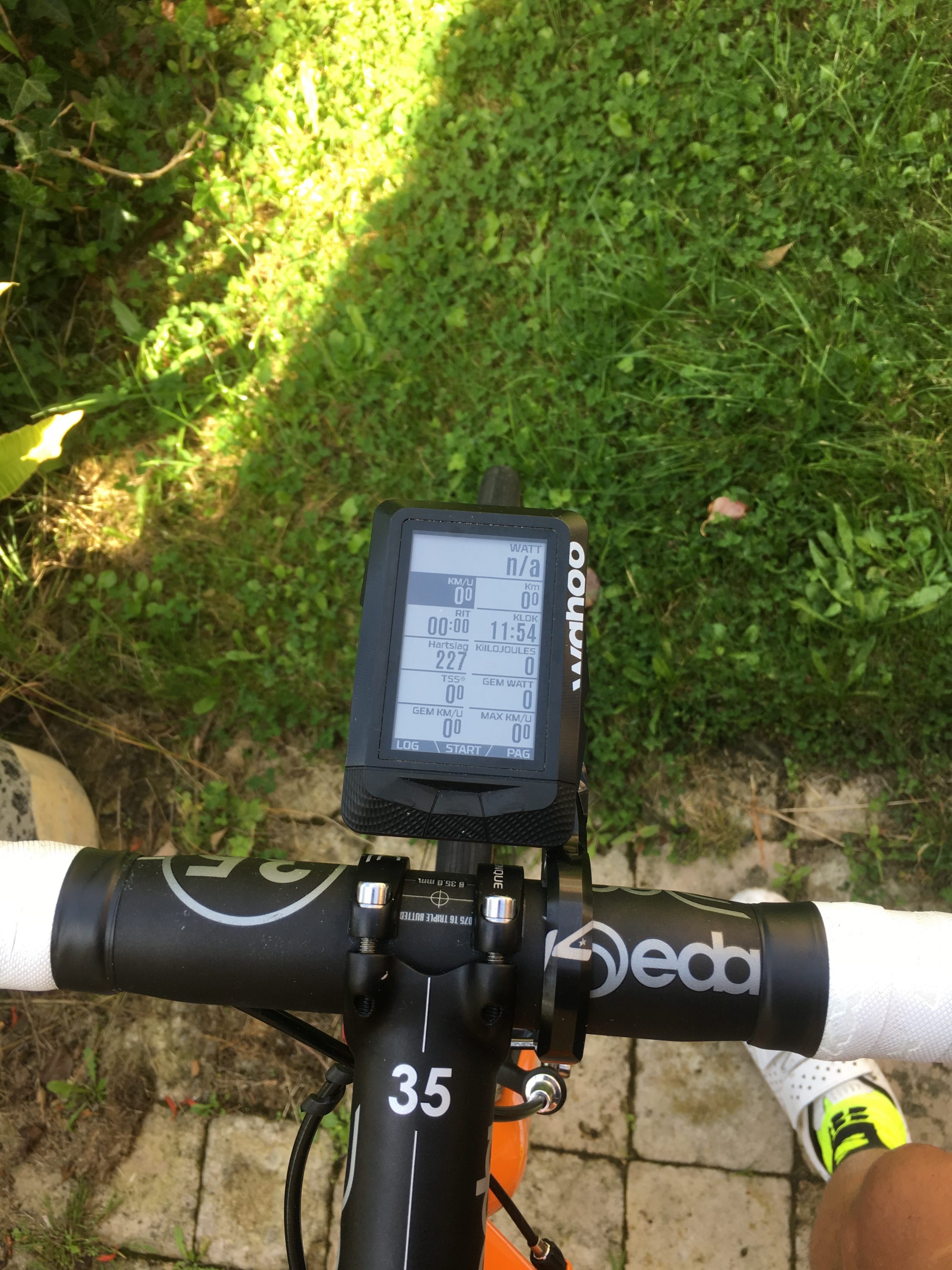Improve your workout with a heart rate monitor

Apr 19, 2021

Improve your workout with a heart rate monitor
Apr 19, 2021

Improve your workout with a heart rate monitor

Apr 19, 2021

To train properly, you need to be able to determine the intensity of your workout. It is not just afterwards that you want to know how hard the training was on your body. Also during the training it helps to know what you are doing. You can of course do this by feel or by looking at the speedometer. But especially for less experienced cyclists, training on intuition is difficult if you haven't developed good reference points. In addition, speed seems a particularly bad advisor when it's windy! Therefore, heart rate monitors (and later: power meters) are the most commonly used methods to determine intensity. Heart rate monitors are cheap and reliable, while power meters are becoming more widespread and also increasingly cheaper. What is the big difference between training on heart rate and on power?
The two problems with heart rate training
It is interesting to know how hard a training session is on your body. That actually determines how tired you become, how much rest you need afterwards, and, in the long run, how much you will improve. Viewed this way, heart rate could be a more interesting training tool than power. However, there are two major problems with heart rate:
The relationship between heart rate levels and how hard the training is on your body varies from day to day
The heart rate reacts to a rise in intensity with a considerable delay.
Nevertheless, even your power output is also not always the same. Every day is different and that means that on some days your performance (or FTP) is slightly lower, making the same power output feel relatively harder. However, you cannot adjust the FTP every day. Therefore, when training on power as well as on heart rate, it is important to always listen to what you feel.
starting too fast and ending too easy.
Your heart rate, but also the speed at which it rises and falls, can be different from day to day. Factors that influence this, often in combination, include: fatigue, altitude, reduced blood volume (after a week of not cycling), caffeine, diet, stress, dehydration.
Even on a good day without all these influences, there is still the problem of lag. Using a HR meter, you have to determine the intensity in the first few minutes of an interval on intuition and then find out if you didn't start too fast or too easy. If you don't do this, as often happens in practice, then you often train too hard at the beginning of the interval and actually train another energy system and too easy at the end. It can therefore happen that someone who does an interval on heart rate ends up training in two completely different zones than was actually intended. Although you should also listen to the feeling and the form of the day with power, you have this problem to a much lesser degree. You can immediately target the power zone that is intended and stay there for the duration of the interval.
What you need to know when training on heart rate.
So is training by heart rate useless? No, far from it, but consider these next few tips.
Listen to what you feel more than when training with power. Take into account that the heart rate can be higher towards the end of your training due to dehydration and fatigue, for example.
Especially up to 90% of your threshold heart rate, your heart rate is a pretty good indicator of what you're doing. Above that, the delay is sometimes too great, as with short intervals, while fatigue may also play too big of a role at very high HR levels.
At short, all-out blocks above the threshold heart rate, do not look at the heart rate, but only listen to your body. The fact that sometimes, even though it was the intention, you don't get above the threshold heart rate is not a problem. But if you fail to reach that level over a couple of training sessions, then it might be a good idea to find out why.
Don't start an interval too fast, but let the heart rate increase slowly. It is better to train a little shorter but in the planned zone, than to completely overshoot the goal.
Make sure you know your threshold heart rate. Establish this in an exercise test in a lab or with a DIY field test. Make sure you regularly do a re-test (at least once a year).
Do not work with formulas such as 220 minus your age. The results of these kinds of calculations can be too wide off the mark.
Finally
Training with a heart rate meter is a good stepping stone to training with power. Once you have mastered it, you will also more easily understand how to use a power meter. When training with power you can keep wearing the heart rate monitor, but you must be careful not to always compare heart rate and power. Why, we explain in another article; Why can't I aways compare my power and heart rate.
To train properly, you need to be able to determine the intensity of your workout. It is not just afterwards that you want to know how hard the training was on your body. Also during the training it helps to know what you are doing. You can of course do this by feel or by looking at the speedometer. But especially for less experienced cyclists, training on intuition is difficult if you haven't developed good reference points. In addition, speed seems a particularly bad advisor when it's windy! Therefore, heart rate monitors (and later: power meters) are the most commonly used methods to determine intensity. Heart rate monitors are cheap and reliable, while power meters are becoming more widespread and also increasingly cheaper. What is the big difference between training on heart rate and on power?
The two problems with heart rate training
It is interesting to know how hard a training session is on your body. That actually determines how tired you become, how much rest you need afterwards, and, in the long run, how much you will improve. Viewed this way, heart rate could be a more interesting training tool than power. However, there are two major problems with heart rate:
The relationship between heart rate levels and how hard the training is on your body varies from day to day
The heart rate reacts to a rise in intensity with a considerable delay.
Nevertheless, even your power output is also not always the same. Every day is different and that means that on some days your performance (or FTP) is slightly lower, making the same power output feel relatively harder. However, you cannot adjust the FTP every day. Therefore, when training on power as well as on heart rate, it is important to always listen to what you feel.
starting too fast and ending too easy.
Your heart rate, but also the speed at which it rises and falls, can be different from day to day. Factors that influence this, often in combination, include: fatigue, altitude, reduced blood volume (after a week of not cycling), caffeine, diet, stress, dehydration.
Even on a good day without all these influences, there is still the problem of lag. Using a HR meter, you have to determine the intensity in the first few minutes of an interval on intuition and then find out if you didn't start too fast or too easy. If you don't do this, as often happens in practice, then you often train too hard at the beginning of the interval and actually train another energy system and too easy at the end. It can therefore happen that someone who does an interval on heart rate ends up training in two completely different zones than was actually intended. Although you should also listen to the feeling and the form of the day with power, you have this problem to a much lesser degree. You can immediately target the power zone that is intended and stay there for the duration of the interval.
What you need to know when training on heart rate.
So is training by heart rate useless? No, far from it, but consider these next few tips.
Listen to what you feel more than when training with power. Take into account that the heart rate can be higher towards the end of your training due to dehydration and fatigue, for example.
Especially up to 90% of your threshold heart rate, your heart rate is a pretty good indicator of what you're doing. Above that, the delay is sometimes too great, as with short intervals, while fatigue may also play too big of a role at very high HR levels.
At short, all-out blocks above the threshold heart rate, do not look at the heart rate, but only listen to your body. The fact that sometimes, even though it was the intention, you don't get above the threshold heart rate is not a problem. But if you fail to reach that level over a couple of training sessions, then it might be a good idea to find out why.
Don't start an interval too fast, but let the heart rate increase slowly. It is better to train a little shorter but in the planned zone, than to completely overshoot the goal.
Make sure you know your threshold heart rate. Establish this in an exercise test in a lab or with a DIY field test. Make sure you regularly do a re-test (at least once a year).
Do not work with formulas such as 220 minus your age. The results of these kinds of calculations can be too wide off the mark.
Finally
Training with a heart rate meter is a good stepping stone to training with power. Once you have mastered it, you will also more easily understand how to use a power meter. When training with power you can keep wearing the heart rate monitor, but you must be careful not to always compare heart rate and power. Why, we explain in another article; Why can't I aways compare my power and heart rate.
To train properly, you need to be able to determine the intensity of your workout. It is not just afterwards that you want to know how hard the training was on your body. Also during the training it helps to know what you are doing. You can of course do this by feel or by looking at the speedometer. But especially for less experienced cyclists, training on intuition is difficult if you haven't developed good reference points. In addition, speed seems a particularly bad advisor when it's windy! Therefore, heart rate monitors (and later: power meters) are the most commonly used methods to determine intensity. Heart rate monitors are cheap and reliable, while power meters are becoming more widespread and also increasingly cheaper. What is the big difference between training on heart rate and on power?
The two problems with heart rate training
It is interesting to know how hard a training session is on your body. That actually determines how tired you become, how much rest you need afterwards, and, in the long run, how much you will improve. Viewed this way, heart rate could be a more interesting training tool than power. However, there are two major problems with heart rate:
The relationship between heart rate levels and how hard the training is on your body varies from day to day
The heart rate reacts to a rise in intensity with a considerable delay.
Nevertheless, even your power output is also not always the same. Every day is different and that means that on some days your performance (or FTP) is slightly lower, making the same power output feel relatively harder. However, you cannot adjust the FTP every day. Therefore, when training on power as well as on heart rate, it is important to always listen to what you feel.
starting too fast and ending too easy.
Your heart rate, but also the speed at which it rises and falls, can be different from day to day. Factors that influence this, often in combination, include: fatigue, altitude, reduced blood volume (after a week of not cycling), caffeine, diet, stress, dehydration.
Even on a good day without all these influences, there is still the problem of lag. Using a HR meter, you have to determine the intensity in the first few minutes of an interval on intuition and then find out if you didn't start too fast or too easy. If you don't do this, as often happens in practice, then you often train too hard at the beginning of the interval and actually train another energy system and too easy at the end. It can therefore happen that someone who does an interval on heart rate ends up training in two completely different zones than was actually intended. Although you should also listen to the feeling and the form of the day with power, you have this problem to a much lesser degree. You can immediately target the power zone that is intended and stay there for the duration of the interval.
What you need to know when training on heart rate.
So is training by heart rate useless? No, far from it, but consider these next few tips.
Listen to what you feel more than when training with power. Take into account that the heart rate can be higher towards the end of your training due to dehydration and fatigue, for example.
Especially up to 90% of your threshold heart rate, your heart rate is a pretty good indicator of what you're doing. Above that, the delay is sometimes too great, as with short intervals, while fatigue may also play too big of a role at very high HR levels.
At short, all-out blocks above the threshold heart rate, do not look at the heart rate, but only listen to your body. The fact that sometimes, even though it was the intention, you don't get above the threshold heart rate is not a problem. But if you fail to reach that level over a couple of training sessions, then it might be a good idea to find out why.
Don't start an interval too fast, but let the heart rate increase slowly. It is better to train a little shorter but in the planned zone, than to completely overshoot the goal.
Make sure you know your threshold heart rate. Establish this in an exercise test in a lab or with a DIY field test. Make sure you regularly do a re-test (at least once a year).
Do not work with formulas such as 220 minus your age. The results of these kinds of calculations can be too wide off the mark.
Finally
Training with a heart rate meter is a good stepping stone to training with power. Once you have mastered it, you will also more easily understand how to use a power meter. When training with power you can keep wearing the heart rate monitor, but you must be careful not to always compare heart rate and power. Why, we explain in another article; Why can't I aways compare my power and heart rate.
More Relevant Articles
Discover valuable training tips to enhance your cycling performance.
More Relevant Articles
Discover valuable training tips to enhance your cycling performance.
More Relevant Articles
Discover valuable training tips to enhance your cycling performance.

Unlock Your Cycling Potential Today
Join thousands of cyclists who have improved their performance with JOIN's training plans.

Unlock Your Cycling Potential Today
Join thousands of cyclists who have improved their performance with JOIN's training plans.
By joining, you agree to our Terms and Conditions and our Privacy Policy.

Unlock Your Cycling Potential Today
Join thousands of cyclists who have improved their performance with JOIN's training plans.
By joining, you agree to our Terms and Conditions and our Privacy Policy.



